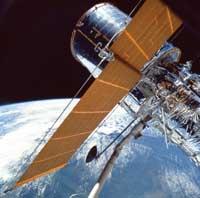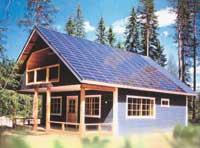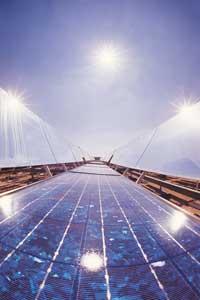Clean and cost-effective solar energy

Solar
panels are common to supply electricity to rural areas that do not have access to the electricity grid, both in developed and developing countries. In the latter the power grid is not widespread and solar panels are very useful, since it is easier, cheaper and cleaner than creating the network. Solar panels are used to illuminate mountain boards, hermitages, hamlets, wineries, schools and hospitals and tens of thousands of photovoltaic installations are currently being worked on. 17% of the photovoltaic modules sold worldwide between 1990 and 94 were destined to supply electricity to rural areas and it is expected that by 2010 these sales will increase to 25%.
Outside rural areas, solar panels are used in traffic light signals, street lamps, clocks, telephones, telecommunication satellites, etc. Another interesting application is water pumping systems, which work very well when water is needed and there is no energy to get out of the subsoil.

These applications are included within the group of autonomous photovoltaic systems, i.e. systems independent of the conventional power grid. In fact, most of those installed are of this type. But the photovoltaic energy has another way of application, the photovoltaic installation associated with the electric grid, that is, in this case in the places where the grid exists are installed panels generating electricity that is sent directly to the network. In this way, instead of light from houses coming from power, thermal or nuclear power plants, light comes from solar panels installed on the roof.
It
would try to pull less of the highly polluting electricity sources and use electricity produced from the Sun when it is too low. At the same time, the distribution of electricity through the grid considerably reduces the costs of adaptation and work. In short, a comfortable and clean application. By the end of 1998, more than 30,000 such facilities existed worldwide, which could reach a million by 2010. So far, however, although in the Spanish state solar panels could join the network, there was no regulation defining how it should be done.
Required
regulations
The San
Sebastian company Solumed works with renewable energies by installing solar panels, among others. According to Xabier Esteban, employee of the same, "the regulation that has just been approved can be considered positive and we hope to encourage more people to place panels". The integration of an installation in the network, according to the decree approved in 1998, forced the managers of the electricity network to pay, "but the way to join, which devices were the most suitable, the relationship between the managers of the network and the client, etc. has been unspecified so far." Since the electricity generated by the panels and the grid is of different frequency, officially at least, the devices of union with the suspicion of the managers of the electricity grid were insufficient. But in the end, despite being largely adapted by themselves, the basic regulations have been reached.

Now, by placing solar panels on the roof and connecting them to the main power grid, you would receive 66 pesetas per kWh produced. Specifically 66 pesetas in the case of the installation of 5 kWh and 36 in those of more than 10, which produce much more electricity. Logically, installation costs are increased proportionally. However, "the installation of 5 kWh is a lot, enough with 4.4 kWh to meet the needs of a large house; a smaller house can be repaired with 2-3 kWh," says Xabier Esteban. The production of solar panels is sold to the network at a price and that of domestic use at a lower price. The installation of 5 kWh generates annual benefits of 600,000 pesetas and 10, 1,200,000.
Will the pocket encourage people more than the environment? They know curious cases of Solumed. For example, in a small town in Spain the neighbors met and among all installed a photovoltaic installation of 15 KWh, sufficient to meet the electrical needs of all and, incidentally, be able to earn money.
Investment for life
"The installation of solar panels is not cheap, a conventional installation of 5 kWh circulates around 4 million and a half, but it must be taken into account that these facilities are forever. The panels are theoretically designed to last about 20 years, but work longer. I, for example, know the panels that have been launched in 1968 and are still underway. They also require very little maintenance."

Photovoltaic
energy is of great interest among renewables: it generates very few residues, does not emit pollutants to the atmosphere (or rivers or seas), does not cause damage to fauna and flora, and is also totally silent, does not produce noise pollution. From an environmental point of view, accumulators are the weakest point of photovoltaic installations, with toxic substances such as lead, nickel and cadmium, which must be cared for and recycled. But photovoltaic energy is generally a clean energy.
The
Sun is an inexhaustible source of energy, at least in the next 6 billion years, without the need for fuel, extraction or transport. It reaches directly to the panels. At the same time, total submission to the sun is one of the major disadvantages of photovoltaic energy: a well-designed photovoltaic installation provides us with energy at any time of day and night, but the generator cannot work without sun, is not able to generate electricity without it, so it is not a suitable system for applications requiring high powers.
Silicon based technology
Photovoltaic solar energy. The term photovoltaic is undoubtedly the most incomprehensible of the three for anyone who does not know much about the subject. But the meaning is quite simple: The energy coming from the Sun in the form of rays, radiations or photons is transformed into electron motion, or what is the same, into electricity. This is done through the mediator called photovoltaic cell, the basic units of solar panels that are installed on roofs and other places. In order of increasing magnitude, cellular assemblies form modules and modular panels.

Photovoltaic cells are formed by layers of semiconductor materials. Semiconductor materials have special electrical properties and can be insulating or conductive depending on temperature. Photovoltaic cells are generally formed by two layers of silicon. When the sun ray touches the cell, electrons jump from one layer to another and, due to demands of the cell design, they must be introduced into the electrical circuit. Due to the continuous arrival of the sun's rays, electrons also jump continuously from one layer to another, generating electrical current through the circuit. This is the secret of photovoltaic cells.
In addition to solar panels, photovoltaic installations have two other main components: the regulator and the accumulator. The accumulator stores the electrical energy produced throughout the day in order to receive constant electric current at times of lower production or during nights (when there is no production). The regulator, for its part, is a safety system that, when the accumulator is full, cuts the current so that it does not suffer any damage.
Published in the supplement Natura de Gara
Buletina
Bidali zure helbide elektronikoa eta jaso asteroko buletina zure sarrera-ontzian











